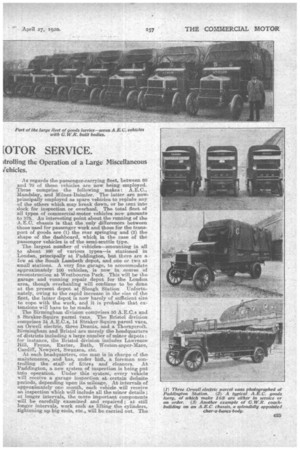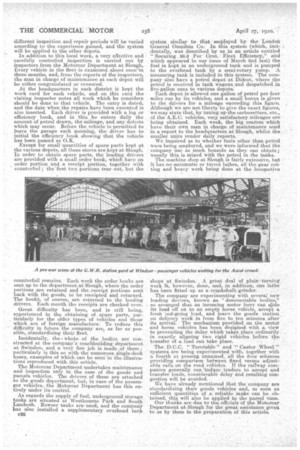THE G.W.R. [OTOR SERVICE.
Page 8

Page 9

Page 10

If you've noticed an error in this article please click here to report it so we can fix it.
A Detailed Description of the Efficient Organ Fleet 'trolling the Operation of a Large Miscellaneous kTehicles.
AN N IMPRESSION prevails in many quarters that the railway companies were forced, during the period of hostilities, to recognize, for the first time, the urgent need of commercial-motor vehicles as a supplement to their existing services. This impression is entirely erroneous. Many of the railway companies were employing considerable fleets of passenger, goods, and parcel-carrying motor vehicles for many years before the wan.
Certainly, the congestion which has occurred through the leek of rolling stock and the bad condition into which many of the engines and trucks fell, owing to the difficulty of overhauling during the wax, has necessitated a large increase in the number of goods-carrying motor vehicles employed by the large railway companies, and, in fact, this need was so great that certain of the companies converted their passenger-carrying vehicles so that they could be used in the transportation of goods, and, for the time being, have had to leave the question of road passenger transport to private enterprise. The L. and N.W. Railway Co. was one of those which had to take this drastic measure.
The G.W. Railway Co. was one of the pioneer cornpa.nie,s to run passenger and goods-carrying vehicles. Their first motor omnibuses commenced running as early as 1903. The chassis of these vehicles were Milnes-Daimlers, and a, surprising proof of their sturdy and lasting construction is afforded by the fact that Np. 1 is still running as a shop lorry at the Slough works, where it is engaged in carrying material to and from the goods station. The first, goods vehicle was placed into service iii 1904, and a. parcel car commenced running in the same year. Up to the time Of the war, the fleet of parcel cars had increased to 43, and the goods-carrying motor-vehicles to 22. At that time, moat of the parcelcars were mainly of Straker-Squire 'a and Thornycroft's manufacture, whilst the heavier vehicles were Milnes:Daimler's make ; there were also some Maudslays and Cornmer Cars and two Wallis and Steevens steam tractors. During the war, the numbers of vehicles in the different fleets remained practically stationary, but now the company have taken _delivery of, or have on order, 60 A.E.C. chassis, all for goods and parcel work.' They have also taken over from the Government, on loan, 108 surplus army vehicles, all at A.E.C. manufacture. They have, as well, seven Orwell electrics, all but one of which are in operation at Paddington, and four G.E.V. electries at Birkenhead.
As regards the passenger-carrying fleet, between 60 and. 70 of these vehicles are now being employed. These comprise the following makes : A.E.C., Maudslay, and Milnei-Dainder. The latter are now principally employed as spare vehicles to replake any of the others which may break down, or be sent into dock for inspection or overhaul. The total fleet of ail typos of commercial-motor vehicles now amounts to 375. Au interesting point about the 1-tinning of the A.E.C. chassis is that the only differences between those used for passenger work and those for the transport of goods are (1) the rear springing and (2) the shape of the dashboard, which in the case of the passenger vehicles is of the semi-scuttle type.
The largest number of vehicles—amounting in all to about 100 of various typos—is stationed in Londen, principally at Paddington, but there are a few at the South Tambeth depot, and one or two at small stations. A very fine garage, to accommodate approximately 100 vehicles, is now in course of reconstruction at Westbourne Park. This will be the garage and -running repair depot for the London area, though overhauling will continue to be done at the present depot at Slough Station Unfortunately, owing to the rapid increase in thesire of the fleet, the latter depot is now barely of sufficient size to cope with the work, and it is probable that extensions will have to be made.
The Birmingham division comprises 50 .A.E.C.s and 8 Straker-Squire parcel irans. The Bristol division comprises 34 A.E.C.s, 14 Straker-Squire parcel vans, an. Orwell electric, three Dennis, and a Thornycroft. Birmingham and Bristol are merely the headquarters of districts including a large number of minor depots for instance, the Bristol division includes Lawrence Hill, Frome, Exeter, Bath, Weston-super-Mare, Cardiff, Newport, Swansea, etc.
At each headquarters, one man is in charge of the maintenance., and has, under hinl, a foreman controlling the staff. of fitter and cleaners. At Paddington, a new system of inspection, is being put into operation. Under this system, every vehicle will receive a garage inspection at certain definite periods, depending upon its mileage.. At intervals of approximately one month, each vehicle will receive an inspection which will include all the minor details.; at longer intervals, the more important components Will be carefully examined 'and repaired ; at still longer intervals, work such as lifting the cylinders, tightening up big ends, etc., will be carried out. The. different inspection and repair periods will be varied accordingto the experience gained, and the system will be applied to the other depots.
In addition to this local work, a very effective and carefully controlled inspection is carried out by inspectors from the Motorcar Department at Slough, Every vehicle in the fleet is examined about once-in three months, and, from the reports of the inspectors, the man in charge of maintenance at each depot will he either congratulated or 'censured.
At the headquarters in each district is kept the work card for each vehicle, and on this card the visiting inspector notes all work which he considers should be done to that vehicle. The entry is dated, and the date when. the. repairs have been executed is also inserted. Each driver is provided with a log or efficiency book, and in this ha enters daily the amount of petrol drawn, the mileage, and any defects which may occur. Before the vehicle is permitted to leave the garage each morning, the driver has to initial the efficiency book showing that the vehicle has been passed as O.K.
Except for small -qua,ntities of spare parts kept at the various depots, all these stores are kept at Slough. In order to obtain spare parts, the leading drivers are provided with a small order book, which have-an order portion and a receipt portion, together with counterfoil; the first two portions tear out, but the counterfoil remains. Each week the order ,hooks are, sent up to the-department,at'Slough, where the order portions are retained and the, receipt portions sent back with the goods, to be receipted and returned. The book, of course,_ are returned to the leading drivers. Each-mouth the receipts are checkedover.
Great difficulty has been, and is still being, experienced in the obtaining of spare parts, particularly for the older types 'of vehicles and those which are of foreign manufacture. To reduce this ' difficulty in future_ the company are, as far as possible, standardizing their fleet.
Incidentally, the whole of the bodies are constructed at the company's coachbuilding• department at Swindon, and a' very fine job is made of them ; particularly is this so with-the numerous single-deck buses, examples of which can be seen' in the illustrations reproduced witlathis article, The Motorcar Department undertakes maintenance and inspection only in the case of the goods and parcels vehicles. The drivers of these are attached to the goods department, hut, in case. of the passenger vehicles, the Motorcar Department has this en.tirely under its control.
As regards the supply of fuel, underground storage tanks are situated at Westbourne Park and South Lambeth. Bowser tanks areused, and the-company has also installed a supplementary overhead tank 026 • system similar to that employed by the. Landon General Omnibirs Co. In this system (which, inci, dentally, waS described by us in an article entitled " Securing 99.9 Per Cent. Fleet Efficiency," and which appeared in our issue of 311arch. 2nd last) the -fuel is kept in an underground tank and is pumped to the overhead tank by a semi-rotary pump. A measuring tank is included in this system. The company also have a petrol depot at Didcot, where the petrol is received in tank wagons, and despatched in five-gallon cans to various depots Each depot is allowed one gallon of petrol per four miles run by its vehicles, and a, small bonus is given to the drivers for a mileage exceeding this figure. Although we are not liberty to give the exact figures, ina.y state that, by tuning up the carb.uretters,. etc., if the A.E.C. vehicles, very satisfactory mileages are being obtained. Each week, the big centres which have their own man in charge of maintenance send in a report to the headquarters at Slough, whilst the smaller units render daily reports.
We inquired as to whether fuels other than petrol were being employed, and we were informed that the company use as much benzolo as they can obtainusually this is mixed with the petrol in the. tanks.
The machine shop at Slough is fairly extensive, but it has no automatic or turret lathes, all the gear cutting and heavy work being done at the locomotive
shops at Swindon.. A great deal of plain, turning work I's, however, done, and, in addition, one lathe has been fitted up as a crankshaft grinder.
The company are experimenting with several new loading devices, known as " demountable bodies," so arranged that an incoming motor lorry can slide. its load off on to an empty horse vehicle, accept a fresh -out-going lead, and leave the goods station on delivery work in from five to ten minutes .after its arrival. The mechanism provided on the motor . and horse vehicles has. been designed. with a view to preventing the delay which takps place ordinarily , in exactly aligning two rigid vehicles before the transfer .of a lead can take place.
-The D:C.C. " Turntable" and " Castor Wheel " Systems are being experimented with, together with a fourth at present unnamed, all the four schemes providing comparison between fixed versus adjust-? able rails on the road vehicles. If the railway companies generally can `induce 'traders to accept q.nd transfer loads, considerable delay and resulting -congestion will be avoided.
We have already mentioned that the company are standardizing their goods vehicles and, so soon as sufficient quantities of a reliable make can be obtained, this will also be applied to the parcel vans.
Our thanks are &te, to the officials of the Motorcar Department at.Slough.for the great assistance given to us by them in the preparation of this article.




























